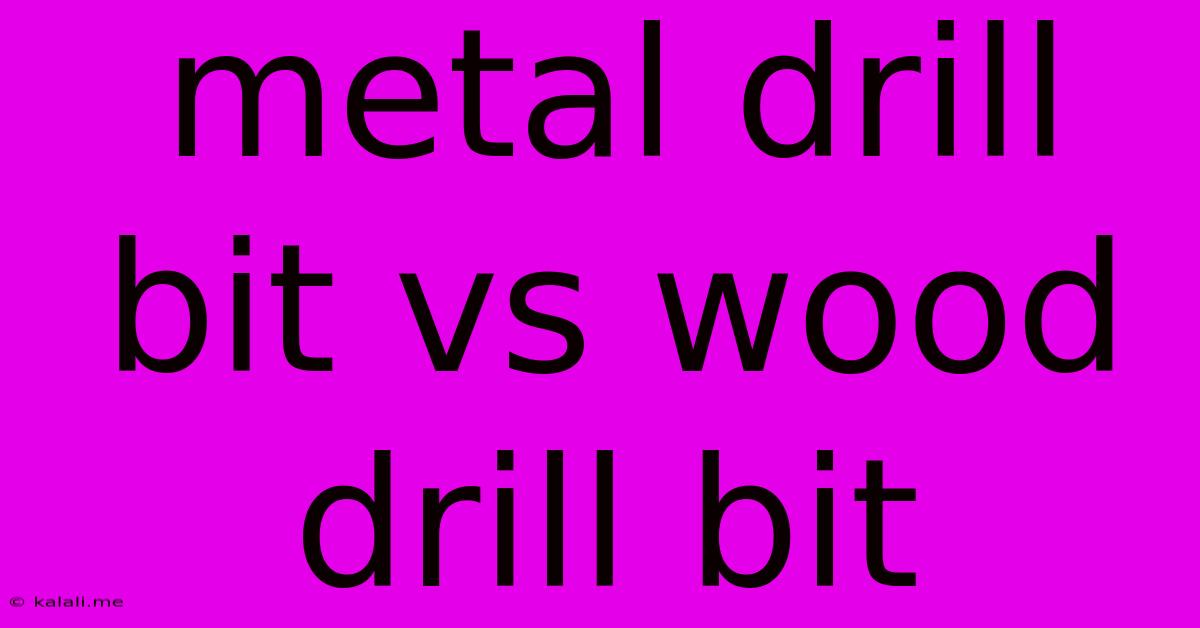Metal Drill Bit Vs Wood Drill Bit
Kalali
May 22, 2025 · 3 min read

Table of Contents
Metal Drill Bit vs. Wood Drill Bit: Choosing the Right Tool for the Job
Choosing the right drill bit can make all the difference between a clean, precise hole and a frustrating, damaged workpiece. This guide breaks down the key differences between metal drill bits and wood drill bits, helping you select the perfect bit for your next project. Understanding the materials and designs will ensure you achieve professional-looking results every time.
Understanding the Differences: A Quick Overview
The primary difference between metal and wood drill bits lies in their tip design and material. Wood bits are designed to cut softer materials, while metal bits are engineered to penetrate tougher, more durable substances. This difference affects both the drilling process and the longevity of the bit.
Metal Drill Bits: Power Through Tough Materials
Metal drill bits are designed for drilling into hard materials such as steel, aluminum, brass, and other metals. Their key characteristics include:
- Stronger Material: Typically made from high-speed steel (HSS) or other durable alloys, ensuring they can withstand the forces involved in drilling metal. Cobalt-alloy HSS bits offer even greater durability and heat resistance for challenging applications.
- Sharp, Defined Point: Features a sharp, pointed tip, often with a split point design, to help center the bit and prevent walking. This ensures accurate hole placement, even in tough materials. The split point reduces the initial force needed to start the drilling process, making it easier to control.
- Durable Flutes: The flutes (the spiral grooves) are designed to effectively remove metal shavings from the hole. These flutes are typically deeper and more robust than those found in wood bits, allowing for efficient chip removal, preventing clogging, and reducing wear.
- Types: Several types of metal drill bits exist, including twist drills (general purpose), jobber drills (versatile), and brad point drills (for precise holes in thin metal sheets).
Wood Drill Bits: Smoothly Through Soft Materials
Wood drill bits, on the other hand, are built for drilling into wood, plastics, and other softer materials. Key features include:
- Durable Yet Flexible Material: Though usually made from high-speed steel, they're often less robust compared to metal bits, as wood doesn't create the same level of friction and stress during drilling.
- Specialized Tip Designs: Many wood drill bits feature a brad point tip. This type of tip features a small, sharp center point that helps the bit precisely start the hole, preventing wandering and creating cleaner entry holes. Other types like Forstner bits create flat-bottomed holes.
- Shorter Flutes: The flutes are generally shallower and less aggressive compared to metal drill bits. This design is suited to the softer nature of wood, preventing splintering and tear-out.
- Types: Several types of wood drill bits cater to specific needs, including twist drills (general purpose), brad point drills (for clean entry holes), Forstner bits (for flat-bottomed holes), and spade bits (for large-diameter holes).
Identifying the Right Bit: A Practical Guide
When selecting a drill bit, consider the following factors:
- Material: The most important factor! Always use the appropriate bit for the material you're working with.
- Diameter: Choose a drill bit diameter that matches your needs.
- Bit Length: Select a bit length that's suitable for the depth of your hole.
- Shank Size: Ensure the shank size of the drill bit matches your drill's chuck.
Using the wrong drill bit can lead to:
- Broken Drill Bits: Attempting to drill metal with a wood bit will likely result in a broken bit.
- Damaged Workpiece: Using the wrong bit can cause splintering, chipping, or inaccurate holes.
- Inefficient Drilling: The wrong bit will lead to slower drilling speeds and poor results.
By understanding the fundamental differences between metal and wood drill bits, you can choose the right tool for the job and achieve professional, accurate results every time. Remember to always prioritize safety and use appropriate safety gear when drilling.
Latest Posts
Latest Posts
-
Sheets Query Select Rows If Column Is Not Null
May 23, 2025
-
Meddle Not In The Affairs Of Dragons
May 23, 2025
-
How Do I Get A House In Riften
May 23, 2025
-
Where Does The Term Mother F Come From Slavery
May 23, 2025
-
Latex Cls Show Abstract If Write Otherwise Omit
May 23, 2025
Related Post
Thank you for visiting our website which covers about Metal Drill Bit Vs Wood Drill Bit . We hope the information provided has been useful to you. Feel free to contact us if you have any questions or need further assistance. See you next time and don't miss to bookmark.